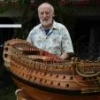
kljang
NRG Member-
Posts
31 -
Joined
-
Last visited
About kljang

Recent Profile Visitors
-
 rcweir reacted to a post in a topic:
What is known about GAWEGM
rcweir reacted to a post in a topic:
What is known about GAWEGM
-
 RossR reacted to a post in a topic:
What is known about GAWEGM
RossR reacted to a post in a topic:
What is known about GAWEGM
-
 Taken Aback reacted to a post in a topic:
What is known about GAWEGM
Taken Aback reacted to a post in a topic:
What is known about GAWEGM
-
 palmerit reacted to a post in a topic:
What is known about GAWEGM
palmerit reacted to a post in a topic:
What is known about GAWEGM
-
 ccoyle reacted to a post in a topic:
What is known about GAWEGM
ccoyle reacted to a post in a topic:
What is known about GAWEGM
-
TMJ, Not all items from China should be tarred with the same brush and labelled “bad”. Nor are all Chinese manufacturers “thieves”. There is certainly one excellent model company from China, CAF Models that is approved on this very site for creating excellent quality models from original research. There reviews of their kits, and build logs so you can see for yourself. The company is run by Cao Feng, or Tom Cao and is based in Shanghai, PR China. I had the pleasure of spending a day with him and his family last month and got a first hand view of his latest products, and I brought him research materials for his next. I will prepare a review of one his latest kits for this site once it arrives. The original poster RolandR did the right thing asking about a particular company. Caveat Emptor is always the watchword! Best regards, Dr. Kerry Jang Vancouver, Canada
-
 James H reacted to a post in a topic:
Kit Review - HMS ENTERPRIZE (1774) by CAF MODELS
James H reacted to a post in a topic:
Kit Review - HMS ENTERPRIZE (1774) by CAF MODELS
-
 pjofc4 reacted to a post in a topic:
Kit Review - HMS ENTERPRIZE (1774) by CAF MODELS
pjofc4 reacted to a post in a topic:
Kit Review - HMS ENTERPRIZE (1774) by CAF MODELS
-
 dunnock reacted to a post in a topic:
Kit Review - HMS ENTERPRIZE (1774) by CAF MODELS
dunnock reacted to a post in a topic:
Kit Review - HMS ENTERPRIZE (1774) by CAF MODELS
-
 JpR62 reacted to a post in a topic:
Kit Review - HMS ENTERPRIZE (1774) by CAF MODELS
JpR62 reacted to a post in a topic:
Kit Review - HMS ENTERPRIZE (1774) by CAF MODELS
-
 CiscoH reacted to a post in a topic:
Kit Review - HMS ENTERPRIZE (1774) by CAF MODELS
CiscoH reacted to a post in a topic:
Kit Review - HMS ENTERPRIZE (1774) by CAF MODELS
-
kit review Kit Review - HMS ENTERPRIZE (1774) by CAF MODELS
kljang replied to kljang's topic in REVIEWS: Model kits
Sorry Scrubbyj, just saw your question. The other manufacturers can steal his design by buying his kit and rescanning his drawings or even parts to create their own CAD files to cut wood themselves. All the work he has done to reconcile any discrepancies between sources is in effect “stolen” by those copying his designs. This practice is not new as in the early days of plastic model kits in the UK and USA, plastic model kit companies produced kits pantographed from another plastic model. You know it when all the errors of the original are faithfully reproduced! I will be in Shanghai next month and will visit Tom from CAF and check out all his new ideas. I’m currently helping him with research for a new kit, but mum’s the word! Cheers, Kerry -
I carried home my kits in my suitcase! I highly recommend visiting the Shizuoka Hobby Show held in May. It is huge and Woody Joe has a booth. They are the only wooden kit maker in Japan. Cheers, Kerry
-
I visited Woody Joe in Shizuoka and met the owner, Mr Tsuneki, and the manager, his daughter, Ms Yukari Gojo. I did an article on my visit for Model Boats magazine in the UK. I have included the .pdf of the article. Woody Joe is a specialist manufacturer of wooden kits (the main business is wood milling) and everything is done in house and they use only the best materials. The wood is imported from SE Asia or domestic woods from Japan (e.g., hinkoi cypress) which is expensive in Japan. The kit selection is based on what the Japanese market prefers as opposed to making what is popular elsewhere. Each kit part is picked by hand and double checked. Kit design is excellent and multimedia. Wood, paper, metal, etch….. whatever works best. Their kits are very popular in Japan and Ms. Gojo says that they cannot keep up with local demand, and they do not market directly overseas. Instead there are resellers. You can buy directly from them, cutting out the middleman. English is not their first language so patience and respect are key if buying direct or contacting them by email. I have their Nippon Maru and I-400 kit, and my wife a temple. Beautifully produced and beautiful when finished. Some of their Edo era Japanese ships were designed by modellers from The Rope Tokyo model building club. The price is a function of specialist timber costs, quality assurance and the high cost of care to ensure quality control. Cheers, Kerry 044 LAND OF THE RISING SUN edited.PDF
-
kit review Kit Review - HMS ENTERPRIZE (1774) by CAF MODELS
kljang replied to kljang's topic in REVIEWS: Model kits
I should add that Tom's products are pirated by other manufacturers! He told me this happens a lot... Cheers, Kerry -
Hi Allan, I didn’t finish building the launch because as you say, didn’t look quite right and left it off. The thing about Bounty kits in general as they include generic boat parts, or the wrong boats, or boats that were never carried. The book reproduces the NMM draughts of a standard launch such as that ordered for Bounty so the modeller can modify the kit parts to a more authentic representation. In general, the biggest issue I had with the DeAgostini model is that there are no plans so you must build it blind - we are a bunch of modellers that work from plans, so building it like a plastic kit is a bit disconcerting. However, after building it I must say it went together well with little problem and looks great. I followed the instructions until the end when I decided to plank it differently to show off more of the frames. If you follow the instructions for example, virtually the entire deck id planked covering up all the intricate beam work. Same with the hull. Planking covers up so much of the frames I left off a lot. I added paint work to bring in some colour. Overall, the kit is a very easy way of building a model in frame. I am not sure of the wood species, mine was a medium hard flecked wood. It had a nice warm colour too it. Warm regards, kerry
-
Thanks Allan, The BOUNTY book was a lot of interesting work because virtually all kits are based on the movie replicas, so a lot of work went into sorting what her colour scheme actually was. Also, John McKay worked out as best he could the actual mast and yard sizes. Bounty was converted from Bethia and her existing rig was altered by the Navy Yard and then by Bligh. It’s all in a large table in the book. Back to the DeAgostini kit, as I note in the book, the frame construction follows the usual practice of the day, but the kit includes only half of them so you can see the interior. John McKay’s Bounty book and plans were used as an inspiration but the kit differs from them in some important ways - actually most kits extant differ from his drawings. But, there are no contemporary illustrations of the ship given her short life so any kit and drawings must be reconstructed from her draughts (which exist) and written log entries. Writing this book was a challenge as the mutiny story is so well known and bringing the reader back to the actual ship herself was an interesting task. I really did not want to retell the story of the mutiny but you have to because it is central to this ship. ‘Fingers crossed’ I got the balance right! warm regards, Kerry
-
I have purchased and built the kit. The model is featured in my new book ShipCraft 30: Bounty to be released in the UK on March 30, a little later in the US. The model was fun and certainly is impressive, but there are some issues that are easily corrected. It is the only Bounty model in frame. I purchased all the instalments at once, and for me made building easier as I could say, make all the guns at once. Cheers, Kerry Jang
-
 kljang reacted to a post in a topic:
Soleil Royal by yancovitch
kljang reacted to a post in a topic:
Soleil Royal by yancovitch
-
 kljang reacted to a post in a topic:
Vasa By 72Nova - FINISHED - Airfix - PLASTIC
kljang reacted to a post in a topic:
Vasa By 72Nova - FINISHED - Airfix - PLASTIC
-
Victory
kljang replied to Jake 1948's topic in Painting, finishing and weathering products and techniques
Hello Jake, I am quite excited that the Victory book will be released in a few weeks. Victory is the first in this series on a sailing warship, and was an experiment to see if it works. I look forward to people’s thoughts on the book when it comes out. The colour profiles were drawn by John McKay (he’s done two books of drawings on the ship) and together we created a number of colour schemes illustrating her appearance at different times during her long career. It was quite a bit of fun compiling information and turning it into a drawings. I hope you find the book helpful, and you can always contact me with any questions from what you find in the book. I am now just finished a new volume for the series on HMAV Bounty, again with colour profiles by John McKay. I need a rest! Warm regards, Kerry -
I’ve written a new book entitled “ship Models from the Age of Sail: Building. And Enhancing Commercial Kits” that might be helpful to you. It was just published by Seaforth Publishing in the UK and Naval Institute Press in the USA. it’s more about kit building so describe planking and rigging, and name kit parts. For the names of actual ship timbers in detail, then Peter Godwin’s books are best. cheers, Kerry Jang
-
ancre Coureur by cafmodel - 1/48
kljang replied to cafmodel's topic in - Build logs for subjects built 1751 - 1800
Amazing work Tom! -
Great review James! I just got an e-mail from Tom saying he has been up late at night doing the castings for the kit! The lessons learned on his Enterprize have really showed up in Le Coureur, but either kit will certainly allow many to build a framed model with a lot less stress and cost. I remember buying shop tools to mill down my own wood, and locating good stocks of hardwood was a task. Looking forward to a build log here soon! Cheers, Kerry
-
Lovely job Kevin. You got tucked in straight away and making great progress. cheers, Kerry
- 312 replies
-
- enterprise
- caf
-
(and 1 more)
Tagged with:
About us
Modelshipworld - Advancing Ship Modeling through Research
SSL Secured
Your security is important for us so this Website is SSL-Secured
NRG Mailing Address
Nautical Research Guild
237 South Lincoln Street
Westmont IL, 60559-1917
Model Ship World ® and the MSW logo are Registered Trademarks, and belong to the Nautical Research Guild (United States Patent and Trademark Office: No. 6,929,264 & No. 6,929,274, registered Dec. 20, 2022)
Helpful Links
About the NRG
If you enjoy building ship models that are historically accurate as well as beautiful, then The Nautical Research Guild (NRG) is just right for you.
The Guild is a non-profit educational organization whose mission is to “Advance Ship Modeling Through Research”. We provide support to our members in their efforts to raise the quality of their model ships.
The Nautical Research Guild has published our world-renowned quarterly magazine, The Nautical Research Journal, since 1955. The pages of the Journal are full of articles by accomplished ship modelers who show you how they create those exquisite details on their models, and by maritime historians who show you the correct details to build. The Journal is available in both print and digital editions. Go to the NRG web site (www.thenrg.org) to download a complimentary digital copy of the Journal. The NRG also publishes plan sets, books and compilations of back issues of the Journal and the former Ships in Scale and Model Ship Builder magazines.




